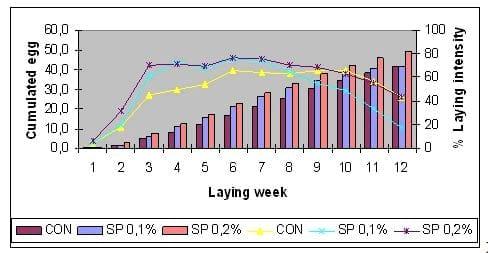Effect of dietary Spirulina supplementation on the reproductive performance of farmed pheasants
Published: January 27, 2010
By: Nikodémusz, E., Páskai, P., Tóth, L. and Kozák, J.; Institute of Animal Husbandry, Szent István University Gödöllő, Hungary
Abstract:
The effect of dietary supplementation with Spirulinaplatensis algae-meal on the reproduction traits was studied in a one-year old pheasant flock. Three groups of penned pheasants with ≈100 hens plus 14 cocks per group were fed a basal diet supplemented with 0 %, 0.1% or 0.2 % algae-meal during the entire laying cycle of 12 weeks. The 0.2% algal group has laid by ≈14% more eggs per hen with a laying intensity higher by 8 %, compared to the control and the 0.1% algal group. The hatching results were also slightly better in the 0.2% algal group.
Introduction
The common pheasant for hunting (Phasianus colchicus colchicus L.) is one of the most important games in Hungary. Pheasants are also bred at several game farms to satisfy the high demand for hunting, as well as pheasant meat and eggs. The profitability of pheasant rearing is basically related to the reproductive value, i.e. the number of eggs as well healthy chicks obtained from one layer.
Microalgae Spirulina rich in valuable components (carotenoids, vitamins A, D, C, E, the B-complex, and minerals) is known to improve laying hen performance. A feeding trial was therefore carried out in a flock of farmed pheasants to study these effects in this game species.
Materials and Methods
The feeding trial was carried out with a one-year old pheasant flock comprising 310 hens and 42 cocks. One week prior to the feeding trial, pheasants were assigned into three groups with 105, 106, and 99 hens and 14-14 cocks. They were kept in 25 m x 12 m =300 m2 laying pens surrounded with wired-net walls of 1.8 m height. The density in the laying pens was 1 head/m2.
Pheasants received a uniform layer diet one week prior to the onset of egg laying. Subsequently, a pelleted basal diet (ME=11.7 MJ/kg, crude protein 16 %) was fed ad libitum without or with Spirulina platensis algae-meal during their entire laying cycle of 12 weeks. The following dietary treatments were used Control (0 supplement), SP 0.1% (0.1% Spirulina) and SP 0.2% (0.2% Spirulina). Drinking water was available at free access.
Egg production per group was daily recorded and cumulated for each laying week. The laying curves were obtained by relating the weekly egg productions to the actual number of hens per group, and overall laying intensity was calculated.
Eggs without shell abnormalities collected over 7 days were set in an incubator (Bretagne La Naconale, France) for 21 days and thereafter transferred into a hatchery for the last 3 days. Altogether 9 hatches were performed. The number of fertile eggs at 10-day candling, and the number of hatched live chicks were recorded per hatch.
Results
Both dietary concentrations of Spirulina algae-meal enhanced laying productivity of hens as shown in Fig. 1.

Fig.1. Laying productivity by control and algal groups
The 0.1% algal group laid by 18% more eggs per hen than controls and with a rate of intensity higher by 11% between weeks 2-8. The corresponding figures for the algal group through weeks 9-12 dropped below the controls' by 33% and 20%, respectively, partly due to a wider sex ratio in the algal group (1:9 vs. 1:6) resulting from a higher mortality of cooks. The overall laying productivity was therefore comparable between these two groups (Table 1).
The 0.2% algal group laid by 21% more eggs per hen than controls and with a rate of intensity higher by 12% between weeks 1-9. Subsequently, the algal group laid only by 1 egg less per hen with a rate of intensity less by 1%, compared to the controls'. Consequently, the overall laying productivity of the 0.2% algal group was superior that of the control and the 0.1% algal group alike (Table 1).
Table 1
Effect of Spirulina algae supplementation on the reproductive traits of pheasant hens
Trait | Treatment | ||
Control | SP 0.1 % | SP 0.2 % | |
Number of hens (head | 94±7 | 95±9 | 90±7 |
Sex ratio | 1:7 | 1:8 | 1:7 |
Eggs laid per hen (piece | 42 | 42 | 49 |
Laying intensity (%) | 50±20 | 50±25 | 58±21 |
Eggs incubated per hen (piece) | 36 | 38 | 43 |
Egg fertility (%) | 78±6 | 80±9 | 78±11 |
Hatch rate (%) | 64±8 | 65±13 | 66±12 |
Hatchability (%) | 82±6 | 81±10 | 84±7 |
The hatching results little differed among the three groups, though both hatch rate and hatchability improved slightly in the 0.2% algal group (Table 1).
Conclusion
Supplementation of pheasants' diet with Spirulina in early to mid laying period seems a useful alternative of artificial lighting to adjust egg production.
Related topics:
Authors:
Szent István University
Szent István University
Recommend
Comment
Share

Would you like to discuss another topic? Create a new post to engage with experts in the community.









.jpg&w=3840&q=75)